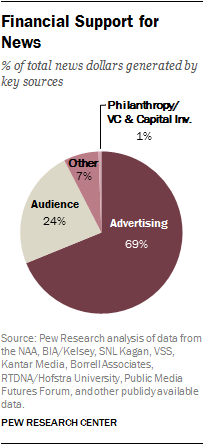State of the News Media 2014
 |
In many ways, 2013 and early 2014 brought a level of energy to the news industry not seen for a long time. Even as challenges of the past several years continue and new ones emerge, the activities this year have created a new sense of optimism – or perhaps hope – for the future of American journalism.
Digital players have exploded onto the news scene, bringing technological knowhow and new money and luring top talent. BuzzFeed, once scoffed at for content viewed as “click bait,” now has a news staff of 170, including top names like Pulitzer Prize-winner Mark Schoofs, and is the kind of place that ProPublica's Paul Steiger says he would want to work at if he were young again.
Mashable now has a news staff of 70 and enticed former New York Times assistant managing editor Jim Roberts to become its chief content officer. And in January of this year, Ezra Klein left the Washington Post for Vox media, which will become the new home for his explanatory journalism concept. Many of these companies are already successful digital brands – built around an innate understanding of technology – and are using revenues from other parts of the operation to get the news operations off the ground.
Other kinds of new revenue are flowing into news operations as well. A new breed of entrepreneurs – like Jeff Bezos, John Henry and Pierre Omidyar — are investing their own money in the industry, in some cases creating wholly new entities and in others looking to bring new life to long-standing ones. Among their best credentials – beyond deep pockets – is that they are tech industry insiders and news media outsiders. Philanthropic money has grown as well, in many cases focused on smaller outlets seeking to fill the gap in news coverage left by legacy cutbacks. As recently as March 2014, the Jerome L. Greene Foundation announced a $10 million grant to New York Public Radio to help build its digital capabilities, an expressed need among nonprofits.
Read the full report at the Pew Research Center's Journalism Project.
View the Media & News Indicators Database.








